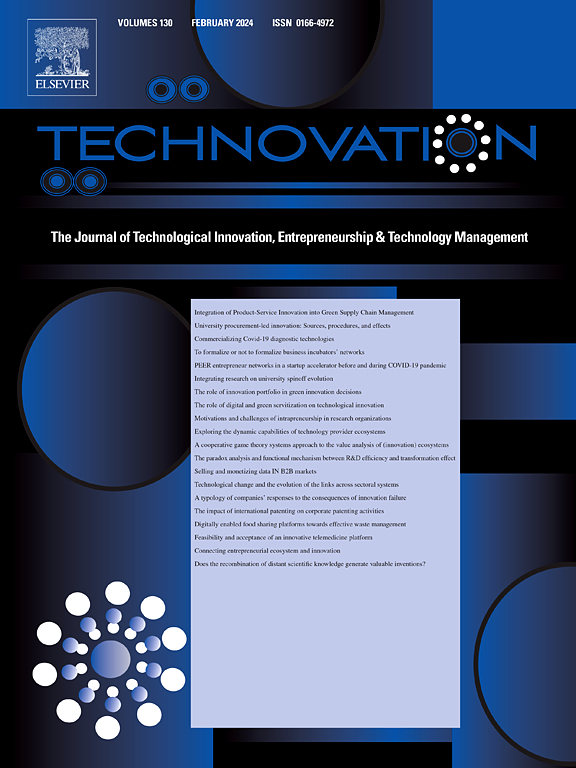Dark side of green subsidies: Do green subsidies to a focal firm crowd out peers’ green innovation?
IF 10.9
1区 管理学
Q1 ENGINEERING, INDUSTRIAL
引用次数: 0
Abstract
Many studies have shown that green subsidies can promote green innovation in recipient firms, but the impact of green subsidies to a focal firm on peer firms' green innovation remains understudied. To fill in this research gap, the current study uses data from 2,155 listed Chinese manufacturing firms and a multi-period difference-in differences approach to examine the impact of green subsidies to a focal firm on peer firms' green innovation. We find that such subsidies negatively affect peer firms' green innovation. Thereafter, we use the attention-based view to examine the role of regulatory focus (promotion and prevention focus) in the relationship between green subsidies and peer green innovation. We find that peer firms' promotion focus weakens the negative effect of green subsidies to a focal firm on peer green innovation, whereas peer firms' prevention focus aggravates this effect. Moreover, we examine the competitive mechanism through which green subsidies to a focal firm crowd out peer green innovation, finding that the crowding-out effect is more pronounced in peer firms with higher market concentration and greater product market share. We likewise investigate the heterogeneous effects of firm, industry, and regional characteristics on the relationship between green subsidies and peer green innovation. Results indicate that green subsidies to state-owned firms, mature firms, high-tech firms, and firms located in pilot low-carbon cities have considerably strong negative effects on peer green innovation. Our study challenges the prevailing view of environmental regulations' positive spillover effects on peer green innovation by highlighting green subsidies' “dark side.” We reveal the crowding-out effect of green subsidies to focal firms on peer green innovation, stimulating scholarly debate on their effectiveness and providing important implications for environmental policies’ enactment.
绿色补贴的阴暗面:焦点企业的绿色补贴是否会排挤同行的绿色创新?
许多研究表明,绿色补贴可以促进接受者企业的绿色创新,但对焦点企业的绿色补贴对同行企业绿色创新的影响尚未得到充分研究。为了填补这一研究空白,本研究利用2155家中国制造业上市公司的数据,采用多期异中异方法考察了重点企业绿色补贴对同行企业绿色创新的影响。研究发现,此类补贴对同行企业的绿色创新产生了负向影响。在此基础上,本文运用关注视角考察了监管焦点(促进焦点和预防焦点)在绿色补贴与同行绿色创新关系中的作用。研究发现,同行企业的促进重点减弱了绿色补贴对同行绿色创新的负面影响,而同行企业的预防重点则加剧了这一影响。此外,我们还考察了重点企业绿色补贴排挤同行绿色创新的竞争机制,发现这种排挤效应在市场集中度高、产品市场份额大的同行企业中更为明显。我们还研究了企业、行业和区域特征对绿色补贴与同行绿色创新之间关系的异质效应。结果表明,国有企业、成熟企业、高新技术企业和低碳试点城市企业的绿色补贴对同行绿色创新具有较强的负向影响。我们的研究通过突出绿色补贴的“阴暗面”,挑战了环境法规对同行绿色创新具有积极溢出效应的主流观点。我们揭示了绿色补贴对企业同行绿色创新的挤出效应,激发了对其有效性的学术讨论,并为环境政策的制定提供了重要启示。
本文章由计算机程序翻译,如有差异,请以英文原文为准。
求助全文
约1分钟内获得全文
求助全文
来源期刊

Technovation
管理科学-工程:工业
CiteScore
15.10
自引率
11.20%
发文量
208
审稿时长
91 days
期刊介绍:
The interdisciplinary journal Technovation covers various aspects of technological innovation, exploring processes, products, and social impacts. It examines innovation in both process and product realms, including social innovations like regulatory frameworks and non-economic benefits. Topics range from emerging trends and capital for development to managing technology-intensive ventures and innovation in organizations of different sizes. It also discusses organizational structures, investment strategies for science and technology enterprises, and the roles of technological innovators. Additionally, it addresses technology transfer between developing countries and innovation across enterprise, political, and economic systems.
 求助内容:
求助内容: 应助结果提醒方式:
应助结果提醒方式:


